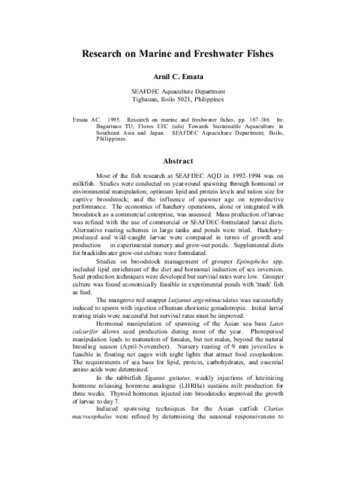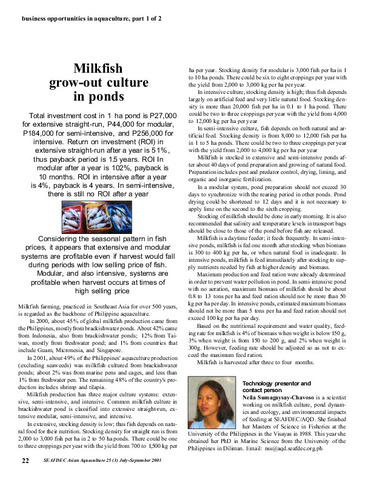Milkfish (Chanos chanos) fingerling production in freshwater ponds with the use of natural and artificial feeds
| dc.contributor.author | Santiago, Corazon B. | |
| dc.contributor.author | Pantastico, Julia B. | |
| dc.contributor.author | Baldia, Susana F. | |
| dc.contributor.author | Reyes, Ofelia S. | |
| dc.date.accessioned | 2013-01-16T03:26:47Z | |
| dc.date.available | 2013-01-16T03:26:47Z | |
| dc.date.issued | 1989 | |
| dc.identifier.citation | Santiago, C. B., Pantastico, J. B., Baldia, S. F., & Reyes, O. S. (1989). Milkfish (Chanos chanos) fingerling production in freshwater ponds with the use of natural and artificial feeds. Aquaculture, 77(4), 307–318. | en |
| dc.identifier.issn | 0044-8486 | |
| dc.identifier.uri | http://hdl.handle.net/10862/1308 | |
| dc.description.abstract | Milkfish fry were reared to fingerling size in freshwater ponds. For the first experiment, fish were fed the blue-green algae Oscillatoria inoculated and grown in the ponds, Oscillatoria supplemented with a fishmeal-based formulated diet, and the formulated diet alone. Twelve 50-m2 earthen ponds were prepared to enhance growth of the indigenous natural foods. Acclimated wild milkfish fry were stocked randomly at 90/m2 and were fed for 6 weeks. Milkfish fed the formulated diet alone had a significantly higher (P<0.05) mean weight gain (1.314±0.201 g) than milkfish given the combination of Oscillatoria and formulated diet (0.882±0.230 g). Growth was lowest for fish fed Oscillatoria alone. The feeding treatments in the second experiment were: combination of Spirulina powder and formulated diet, formulated diet alone, and rice bran alone. The stocking rate was equivalent to 91.5–92.5 fry/m2 and feeding lasted for 7 weeks. All feeds promoted some growth but the milkfish fed the formulated diet alone invariably had the highest weight increment (1.504±0.167 g), followed by fish given the feed combination (0.881±0.140 g). Rice bran alone gave the lowest growth response. For both pond experiments, growth trends of the young milkfish were similar to those grown under laboratory conditions. Although survival rates were significantly different in one aquarium experiment, survival rates of milkfish in ponds did not differ significantly (P>0.05) among treatments. | en |
| dc.language.iso | en | en |
| dc.publisher | Elsevier | en |
| dc.subject | milkfish | en |
| dc.subject | Chanos chanos | en |
| dc.title | Milkfish (Chanos chanos) fingerling production in freshwater ponds with the use of natural and artificial feeds | en |
| dc.type | Article | en |
| dc.identifier.doi | 10.1016/0044-8486(89)90215-9 | |
| dc.citation.volume | 77 | |
| dc.citation.issue | 4 | |
| dc.citation.spage | 307 | |
| dc.citation.epage | 318 | |
| dc.citation.journalTitle | Aquaculture | en |
| seafdecaqd.library.callnumber | VF SJ 0270 | |
| seafdecaqd.databank.controlnumber | 1989-27 | |
| dc.subject.asfa | artificial feeding | en |
| dc.subject.asfa | feeding experiments | en |
| dc.subject.asfa | fish larvae | en |
| dc.subject.asfa | cultured organisms | en |
| dc.subject.asfa | growth | en |
| dc.subject.asfa | pond culture | en |
| dc.subject.asfa | fish culture | en |
| dc.subject.scientificName | Chanos chanos |
Files in this item
| Files | Size | Format | View |
|---|---|---|---|
|
There are no files associated with this item. |
|||
This item appears in the following Collection(s)
-
Journal Articles [1256]
These papers were contributed by Department staff to various national and international journals.



